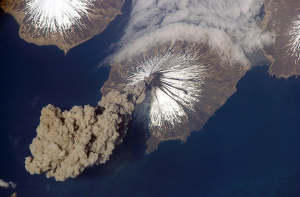Human Carbon Dioxide Emissions Dwarf Annual Volcanic Emissions
Human Carbon Dioxide Emissions Dwarf Annual Volcanic Emissions

Yes, aerosols from volcanic eruptions cool the climate, but don’t carbon dioxide emissions from the same eruptions counteract this
cooling? No, at least not significantly.
Terrance Gerlach, scientist with the U.S. Geological Survey, untangles this commonly misconstrued reality in the American Geophysical Union’s EOS June 2011 issue. The amount of carbon dioxide emitted by volcanoes, Gerlach affirms, is inconsequential when compared to human emissions. He calculates that humans emit the equivalent amount of carbon dioxide as the 1991 Mt. Pinatubo eruption every 12.5 hours. Every 2.7 days, we emit the equivalent amount of carbon dioxide released by volcanoes during an average year. Our ubiquitous and unabated emissions easily dwarf volcanic emissions, and the cooling effect of volcanic aerosols from a single catastrophic event is much larger than the average annual warming effect of volcanoes worldwide.
There have been periods in Earth History, however, when volcanic carbon dioxide emissions may have been more significant in global climate. Roughly 640 million years ago, for example, volcanic emissions may have pulled the Earth out of a global glaciation. During this glaciation, called Snowball Earth, the Earth is thought to have been sealed in ice as thick as 1 kilometer in some regions, tapering down to less than than 2 meters at the equator. In such a scenario, the atmospheric-oceanic-terrestrial carbon cycle would have slowed down to a near standstill, seriously hindering the Earth’s natural thermostat. Volcanic eruptions, both sub-marine and sub-glacial, may have been the one source of carbon dioxide available to thaw the snowball.
According to studies led by Paul Hoffman, Professor Emeritus at Harvard University and a leader in Snowball Earth research, carbon dioxide from volcanic emissions could have leaked through weakly-frozen regions of the equatorial ocean and cracks in terrestrial glaciers, slowly warming the atmosphere. With essentially all carbon sinks sealed off, this carbon dioxide would have built up unabatedly in the atmosphere. Over the course of millions of years, enough could have accumulated to end Snowball Earth.
So, yes, volcanoes may contribute to significant climate warming, but only over the extended course of geologic time. Over the course of the 21st century, a mere blink in geologic time, we can safely assume that, if anything, volcanoes will cool global climate.
Posted by Laura Poppick, Assistant Editor of Maine Climate News.
